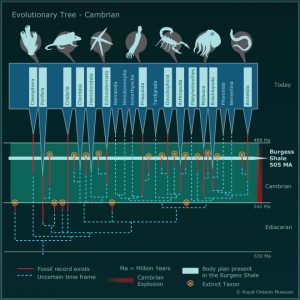“I cannot doubt that all the Silurian trilobites have descended from one crustacean, which must have lived long before the Silurian age…Consequently, if my theory be true, it is indisputable that before the lowest Silurian strata was deposited, long periods elapsed, as long as, or probably longer than, the whole interval from the Silurian to the present day…The case must at present remain inexplicable; and may be truely urged as a valid argument against the views here entertained.”
Charles Darwin, On the Origin of Species, 1859

You have to admire the sort of person who points out the flaws in their theories before their critics get a chance to. First of all it shows that they’re honest enough to admit they don’t know everything, that even the best ideas aren’t perfect. Yet at the same time by pointing out the problems in their work up front they take some of the wind out of their opponent’s sails.
What we now call the Cambrian explosion was just such a problem for Darwin and his theory of Evolution by Natural Selection. Examining the fossil record, it appears as if all of the major forms of animal life, everything from arthropods to mollusks, segmented worms to starfish all came into being somewhere between 550 and 500 million years ago. The image below shows what kind of life inhabited the Cambrian.

That was the way it appeared to Darwin back in 1859, but in the 150 years since then we have made some progress. We now have an enormous amount of evidence for single-celled life forms dating back more than two billion years before the Cambrian. We also now have fossils of a group of multi-cellular creatures that lived 60-80 million years before the Cambrian, known as the Ediacarana fossils. Nevertheless, the Cambrian explosion is still one of the biggest problems in evolutionary theory. The image below shows how the diversity of life grew during the Cambrian.

A new paper has been published by a team of paleontologists at Oxford University and the University of Lausanne which asserts that, while the rate of evolution was very high during the Cambrian the major changes were spread out over the entire 50 million year period, a really slow explosion in other words. According to lead author Professor Allison Daley of Oxford’s Museum of Natural History ‘…the Cambrian explosion, rather than being a sudden event, unfolded gradually over the ~40 million years of the lower to middle Cambrian.”
What Professor Daley and her colleagues did was to carry out the most comprehensive survey of the early fossil group Euarthropoda, a group that includes all of the arthropods (insects, spiders, crustaceans and trilobites etc.) along with similar now extinct creatures. What they found was that during the Cambrian radiation of the Euarthropoda into distinct sub-groups and species took place at a high but nevertheless steady rate over the period of ~40 million years.
At the same time a number of different physiological characteristics, such as an exo-skeleton, jointed limbs, compound eyes and the earliest biting jaws came into existence, but again gradually, one part at a time. In precise detail Professor Daley et al show how the Euarthropoda grew and diversified throughout the Cambrian, rapidly but not explosively. The paper estimates that the speed of evolution during the Cambrian was about five times that in the many years since.
Still the paper leaves unanswered the question of why the rate of evolution should have been five times higher during the fifty million years of the Cambrian. Several possible explanations for the high rate of evolution during the Cambrian have been advanced over the last several decades; arguable the two best are interrelated.
The first explanation proposes that the evolution of the first predator species caused other species to have evolved rapidly in order to develop some means of protection from the predators. Naturalists have in fact studied the effect of inserting a predator into a previously peaceful ecological niche and have found that the rate of evolutionary charge increases dramatically.
The second explanation deals with one of those means of protection, the development of hard parts. It was in fact during the Cambrian period that the first animals with hard parts, shells and exo-skeletons, evolved. Combining these two ideas some evolutionary biologists have described the Cambrian explosion as an arms race with new species finding new ways to eat other species while the other species desperately try to find new ways to not get eaten.
Whatever the cause, the Cambrian period was the time when both the kinds of living creatures and the modes of living that we recognize today came into existence. Explosion or not it was a very important period indeed.
